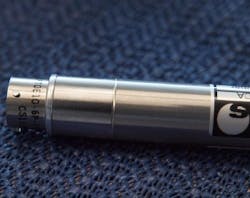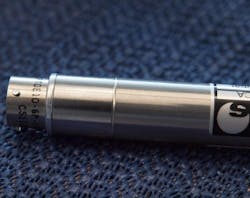Laser welding of pressure sensors integrated at record speed
Kaufbeuren, Germany - Imes GmbH manufactures high-temperature resistant pressure sensors that are supplied to manufacturers of engines for large ships and static engines, generally with power ratings from 250 kW to 18 MW. In 2011, sales of Imes' measuring cells for large gas and diesel engines increased beyond expectations, breaking every record in the company's 15-year history and raising the challenge of doubling production by the turn of the year.
Those record sales were the result of two global trends: climate protection and energy production from renewable raw materials. Climate protection forces the shipping industry to gradually substitute diesel fuel with liquefied natural gas to reduce CO2 emissions. Efficient and reliable combustion of varying fuel types requires considerable improvements in the engine management, based on adding measuring sensors in the cylinder block.
Energy from biogas poses a different challenge. The level of methane, the energy carrier, varies as much as does the composition and quality of raw materials and conditions of microbial degradation. Biogas engines have to maintain efficient combustion with varying fuel qualities while attaining high running times. This again requires intelligent motor management -- with sensor-technology supplied by Imes.
The company's key product, the cylindrical pressure sensor, measures pressures up to 300 bar, while withstanding temperatures of up to 300 °C. A tube made of stainless steel, which houses a thin-fllm technology measuring sensor, is screwed into the cylinder block. Another tube containing signal processing electronics connects to the engine management system. Multiple manufacturing steps require the hermetic sealing of these stainless steel tubes containing sensitive electronics.
Imes had initially used adhesive joining technology, but this suffered from the extreme vibrations encountered during operation times which average 10,000 hours. Subsequently, an external sub-contract manufacturer was used to hermetically seal the tubes using a laser welding system. Laser welding is ideally suited for precise and robust stainless steel joints. In addition, as parts are processed without any application of force and the heat input is both low and highly localized, the laser is the perfect solution for welding sub-assemblies which contain delicate, heat-sensitive electronic. Imes made the decision to introduce the laser welding for in-house production in order to shorten lead-times and streamline logistics. With no prior experience of laser technology, the company made contact and sent samples to Rofin Baasel for advice. Rofin's application engineers developed the optimum laser setup for the samples.
A Select laser workstation, equipped with an additional rotary axis, was a perfect fit for this application. The CNC-driven rotary axis allows for a fully-automated process, ensuring that each and every part is welded with the optimum parameters, e.g. laser power, pulse frequency, pulse shaping, and feed rate. Guaranteeing process stability is a key issue for Imes, because if a sensor malfunctions in a ship's engine it is no trivial matter.
Within a few days of receiving the sample parts, Rofin demonstrated the solution in its application lab. Imes was convinced; moreover, investment costs met their expectations.
System installation and setup occurred over a two-day period where Imes engineers learned everything they needed to know about daily operation of the system, with set-up procedures for new applications. Operating the fully-automated CNC-driven system in production is straightforward, which enhances flexibility within the workplace as different employees are capable of operating the laser welding system. Full production of the sensor with the new in-house laser welding system commenced very quickly following the brief training program.
Today, the in-house laser welding system helps Imes to organize production in a much more flexible and responsive manner. Production has increased 20%, and the quality of Imes' own weld seams is considerably better than the parts welded by the external contractor. Managing director Stefan Neumann is very happy with his decision: "We wanted to introduce a new production technology in a very short time. I never would have thought that operating a laser welding system is that easy."
[From a Rofin Baasel user report]

